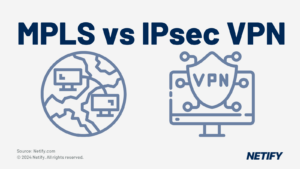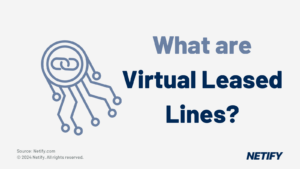| Virtual Private LAN Services offer private, low-latency, Layer 2 network connectivity, enabling seamless LAN extension across dispersed locations. |
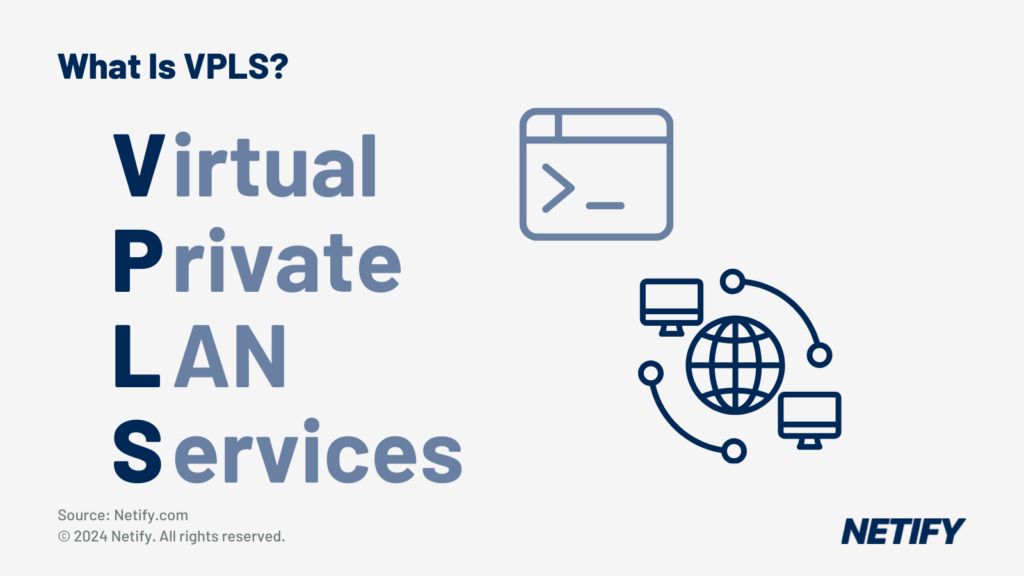
The majority of businesses are opting for the provision of SD-WAN services to provide for their branch office and remote user connectivity.
The nature of how organisations work today and how focused every business is on their cloud applications and storage dictates a need to deliver solutions which encompass network cybersecurity. Gartner defined SASE (Secure Access Service Edge) as a framework to enable IT decision makers to better understand the components required to deliver end-to-end network security.
Despite SASE (and SD-WAN), Layer 2 VPLS network connectivity remains a requirement for organisations needing to privately extend their LAN addressing across disparate UK sites. There are certain scenarios where layer 2 solutions offer high-speed, secure, low-latency connectivity to support sensitive data and even non-IP traffic or legacy applications. Netify notes that finance and healthcare are utilising layer 2 VPLS to connect campus networks together where short-haul data services do not offer the reach required.
What is VPLS in Networking and How Does It Compare to Other Solutions?
VPLS extends an organisation’s LAN (Local Area Network) across distances by leveraging the network of service providers. The capability allows IT teams to manage their own VLANs and routing protocols without the need to rely on layer 3 routing, which is associated with MPLS-based services. While SD-WAN is the right solution to optimise bandwidth, and make use of multiple circuit types, VPLS can be incorporated with SD-WAN technology to provide privacy and layer 2 control is between campus buildings.
Comparing VPLS vs MPLS, which one is right for you?
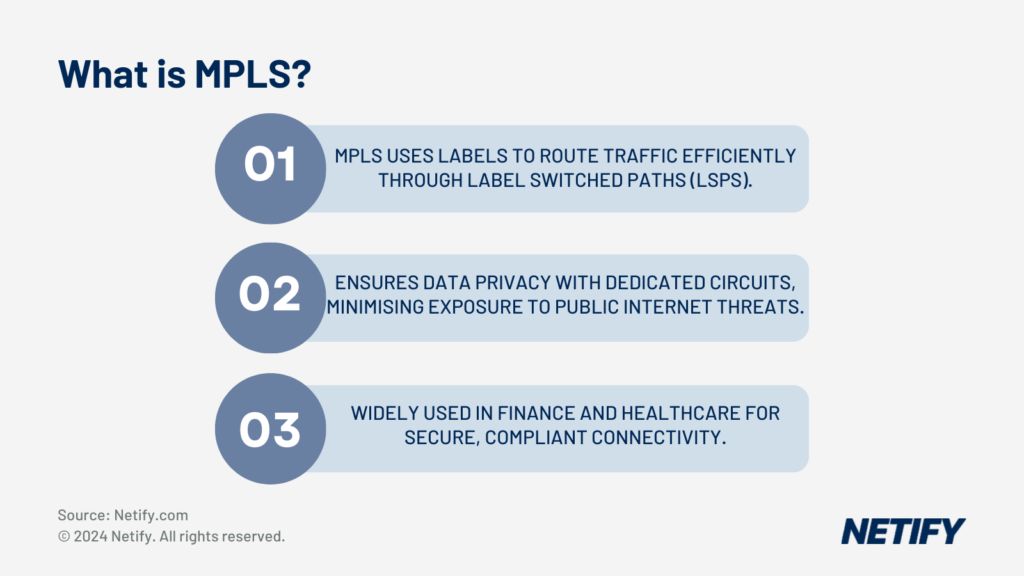
Layer of Operation
MPLS operates at layer 3 of the OSI model, meaning that forwarding decisions are based on the IP address, so extending LAN services is not possible. Layer 2 VPLS operates at layer 2, creating virtual LANs over wide area networks where there is a need to extend Ethernet-based connectivity between branch offices. The way to think of VPLS and MPLS is that they are broadly the same as both services are provisioned over a service provider network infrastructure. The business connects to the service provider network to extend their reach; the choice of VPLS vs MPLS is dependent on whether LAN extension is required.
Scalability
MPLS is perceived as more scalable when compared to VPLS, but only very large deployments need to be mindful of scaling issues. VPLS is scalable within the context of extending Ethernet LAN services for the majority of business sizes; there could be limitations if the VPLS services are required at scale.
Control and Routing
With MPLS solutions, the service provider is responsible for the control of routing decisions and network management. VPLS hands over control of these elements to businesses; routing and VLANs can be controlled by your IT team, allowing management of layer 2 network traffic independently of the service provider network.
Use Case Suitability
MPLS is better suited for organisations that require private connectivity where the control aspect is firmly within the IP routing realm. Although MPLS has declined, industries needing strong QoS and secure WAN connectivity may still opt for a hybrid of SD-WAN and MPLS.
VPLS is a good fit for businesses looking to extend their LAN across dispersed locations without the need to route at the IP level. We are seeing more businesses with VPLS and SD-WAN hybrid networks compared to MPLS and SD-WAN hybrid networks.
VPLS vs SD-WAN VPN: Which is Right for Your Business?
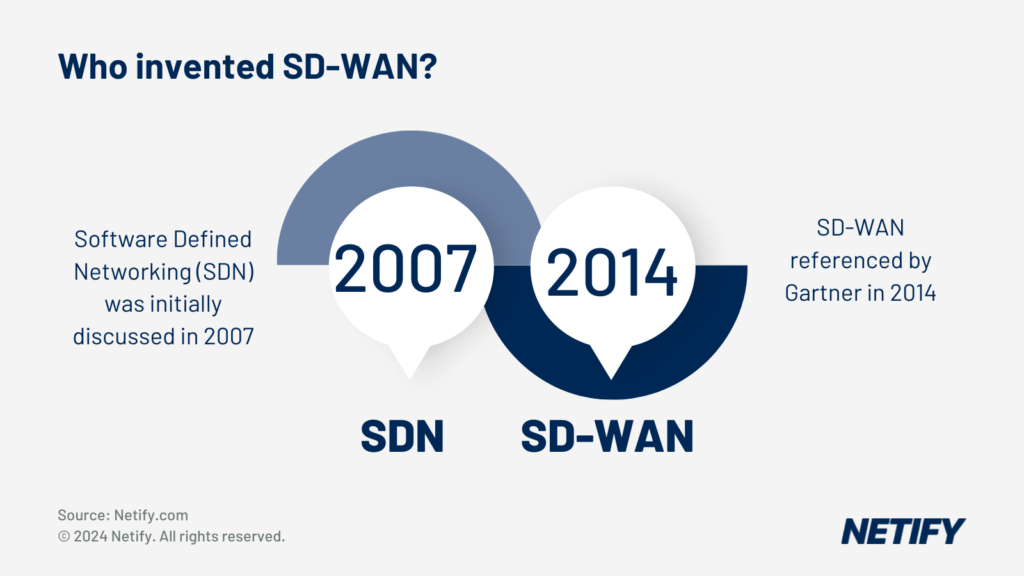
Another common comparison, but perhaps more straightforward, is VPLS vs VPN. While both can be used to connect multiple sites, VPLS is perceived as more secure, with low-latency connectivity backed by a service provider SLA.
SD-WAN can replicate certain Layer 2 aspects of VPLS, though with important distinctions. SD-WAN operates primarily at Layer 3 (the network layer), but it can deliver some similar Layer 2 functions that are traditionally offered by VPLS through the use of specific configuration or tunneling.
Here are some ways SD-WAN can approximate VPLS’s Layer 2 functionality:
- Tunneling Protocols: SD-WAN can use tunneling protocols which include Virtual Extensible LAN (VXLAN) or Ethernet over GRE (Generic Routing Encapsulation) to extend Layer 2 domains across WAN links.
- Encapsulation of Layer 2 Traffic: Certain SD-WAN solutions support Layer 2 encapsulation, allowing them to carry Ethernet frames between sites. This is similar to VPLS, which natively operates at Layer 2, creating a virtual LAN across the WAN.
- Site-to-Site Connectivity: SD-WAN can provide secure, multipoint connectivity between different locations, though it typically does this at Layer 3. However, when configured correctly, SD-WAN can emulate Layer 2 connectivity to offer a similar user experience where devices on different sites appear to be on the same network.
- Overlay Networks: SD-WAN creates an overlay network that abstracts underlying transport mechanisms (MPLS, broadband, LTE, etc.). By implementing Layer 2 overlays, SD-WAN can simulate some of the VLAN-based segmentation and site-to-site transparency provided by VPLS.
Key Differences:
Traffic Handling and QoS: VPLS is ideal for low-latency applications and environments requiring tight control over Layer 2 broadcasts. SD-WAN, being a Layer 3 technology, optimises routing decisions dynamically and manages bandwidth—SD-WAN may not handle Ethernet broadcasts or Layer 2 protocols as effectively.
Layer of Operation: VPLS directly extends Layer 2 connectivity across the WAN, making it easier to extend VLANs and achieve seamless LAN extension. SD-WAN primarily operates at Layer 3 but can be configured to carry Layer 2 traffic when needed, though this typically requires more setup.
In summary, VPLS remains more effective for environments that demand strict Layer 2 transparency and control, such as those involving non-IP traffic. SD-WAN is more flexible for Layer 3 networking but can support Layer 2 needs in specific scenarios.
Which VPLS providers should you compare?
1. BT Business UK VPLS
BT’s VPLS service is available in 200 countries and supported by more than 5,000 Points of Presence (PoPs). BT also offers full control over traffic management, allowing businesses to manage their own VLANs and routing configurations.
The BT VPLS SLA offers 99.99% uptime guarantee with commitments to latency and jitter response times and fault handling to ensure network performance is maintained and that issues are addressed quickly.
BT is a well-known provider of VPLS network services in the UK; their network reach and capability means they are a good choice to make your shortlist.
Key Features:
- UK Points of Presence (PoPs): BT operates a significant network of VPLS PoPs across the UK.
- Managed and Self-Managed Options: Businesses can choose between fully managed VPLS services or self-manage their VLANs and routing configurations.
- 99.99% Uptime SLA: BT offers a strong Service Level Agreement (SLA) for UK VPLS services across availability and performance with quick fault resolution.
- Direct Cloud Access: Local connections to cloud providers which include Google Cloud, AWS, and Microsoft Azure from UK PoPs.
- Local Support: BT provides 24/7 support for UK businesses, including local language and expertise.
Example deployment:
A large financial institution with branches across Europe needed low-latency, high-performance networking. BT Business implemented a VPLS solution that unified their sites across high-speed connections to improve data transfer.
Example partnerships:
BT collaborates with major vendors, including Cisco and Juniper to deliver advanced VPLS service capability.
2. Colt UK VPLS
Colt’s VPLS solution is aimed at delivering VPLS Ethernet connectivity across Europe, Asia, and North America. What sets Colt apart is their dedicated fibre network which spans 29,000 buildings globally. Although their global reach is not applicable to UK deployments, Colt has a number of UK-wide lit buildings providing low-cost entry into their VPLS network infrastructure.
One of Colt’s key differentiators is its focus on low-latency network connectivity, which has been adopted by financial services, media production, and cloud-based businesses where millisecond delays can impact operations. Colt’s VPLS service provides deterministic routing to ensure that traffic prioritisation and bandwidth allocation are tightly managed.
Colt offers a 99.99% uptime SLA with customisable Quality of Service (QoS) policies, allowing businesses to prioritise different types of traffic based on operational needs.
Key Features:
- UK Fibre Network: Colt’s UK network spans key business hubs, connecting thousands of buildings across the UK via dedicated fibre infrastructure.
- Low-Latency Performance: Colt’s UK network is optimised for businesses requiring low-latency, particularly for financial services and media companies.
- Custom QoS Policies: UK businesses can set custom Quality of Service policies, prioritising critical applications like voice, video, and real-time data transmission.
- Private Fibre Access: Colt offers direct fibre access across the UK to reduce reliance on third-party providers and improve overall network performance.
- UK Data Centre Interconnects: Colt connects multiple data centres across the UK, offering fast inter-site communications.
Example deployment:
A financial services firm operating in London required a low-latency, high-bandwidth network to handle real-time trading data. Colt’s VPLS solution provided direct fibre connections between their offices to ensure critical trading data could be transmitted with minimal delay.
Example partnerships:
Colt has strong partnerships with networking equipment manufacturers, which include Arista and Juniper.
3. GTT UK VPLS
GTT operates one of the largest Tier 1 IP backbones, covering 600+ Points of Presence (PoPs) in over 100 countries, making their VPLS capability a good choice for enterprises that require global connectivity. A key differentiator for GTT is its focus on providing direct access to cloud platforms, which include AWS, Microsoft Azure, and Google Cloud.
GTT offers low-latency routing paths across their backbone, which is designed to support industries that rely on rapid data transfers, such as financial services and media.
Key Features:
- UK Points of Presence (PoPs): GTT operates PoPs in major UK cities in addition to global capability.
- Low-Latency Routing: GTT’s UK backbone is designed for industries that rely on fast data transmission.
- Cloud Integration: Local access to AWS and Microsoft Azure from UK PoPs to support hybrid cloud strategies within the country.
- Custom QoS: GTT allows UK businesses to implement specific Quality of Service (QoS) policies for optimising local network traffic.
Example deployment:
A London-based media company required a low-latency, high-bandwidth solution to transfer large video files between UK offices and a data centre. GTT’s VPLS solution enabled high-speed, reliable data transfer through its extensive PoPs in the UK.
Example partnerships:
GTT has partnered with major cloud providers, including AWS and Microsoft Azure with direct cloud connectivity.
4. Cogent: UK VPLS
Cogent’s VPLS service is recognised for their focus on delivering cost-effective connectivity across their Tier 1 global network. With over 95,000 km of fibre infrastructure, Cogent offers one of the largest independent networks, deploying VPLS without the high costs typically associated with enterprise-grade solutions.
A key strength of Cogent’s VPLS offering is its ability to prioritise mission-critical traffic through its custom Class of Service (CoS) options; businesses can define traffic priorities based on their operational needs. Cogent’s low-latency network is particularly beneficial for industries requiring fast data transmission, such as healthcare, financial services, and large retailers.
Key Features:
- UK Fibre Network: Cogent’s fibre infrastructure connects key locations across the UK.
- Cost-Effective Solutions: Cogent is known for delivering competitively priced VPLS services within the UK.
- UK PoPs: Cogent operates several PoPs within the UK, providing reliable and consistent local connectivity.
- Custom Class of Service (CoS): UK businesses can define custom Class of Service priorities to ensure critical traffic is prioritised within the local network.
Example deployment:
A UK-based financial services firm needed cost-effective, high-performance connectivity between their London headquarters and regional offices. Cogent implemented VPLS service over their fibre network, delivering low-cost, high-reliability connections that ensured secure and fast data transfers across the organisation’s sites.
Example partnerships:
Cogent works closely with networking equipment providers such as Juniper Networks to enhance its VPLS and Ethernet offerings.
5. Expereo: UK VPLS
Expereo offers DIY and managed VPLS services with a strong focus on both the UK and global connectivity. Expereo operates in over 200 countries, making their VPLS capability an ideal solution for businesses needing extensive geographic coverage. A notable differentiator for Expereo is their carrier-neutral approach—businesses can access multiple carriers globally to optimise routes for performance and reliability.
Expereo’s VPLS services are particularly suited to hybrid cloud environments. Their VPLS service can connect to AWS, Google Cloud, and Azure. Expereo also offers proactive network monitoring to track network performance in real-time.
Key Features:
- Carrier-Neutral UK Coverage: Expereo leverages multiple UK carriers to ensure optimised routing and performance across the UK.
- Proactive Network Monitoring: Expereo offers real-time monitoring of UK VPLS services to track network performance and resolve issues quickly.
- UK PoPs: Expereo operates multiple PoPs within the UK to lower overall costs and provide network diversity.
- Cloud Connectivity: Expereo provides direct connections to UK-based cloud services.
Example deployment:
A retail chain with multiple UK locations required a managed VPLS service to connect their stores and headquarters in a cost-effective manner. Expereo’s VPLS solution provided carrier-neutral access across UK locations to improve real-time inventory management and operational cost reduction by optimising the network for performance.
Example partnerships:
Expereo collaborates with multiple carriers in the UK and Europe, allowing businesses to access a wide range of connectivity options through its carrier-neutral VPLS platform. Expereo also partners with cloud service providers and has a strong partnership with Cisco Meraki to deliver integrated SD-WAN and VPLS solutions.
